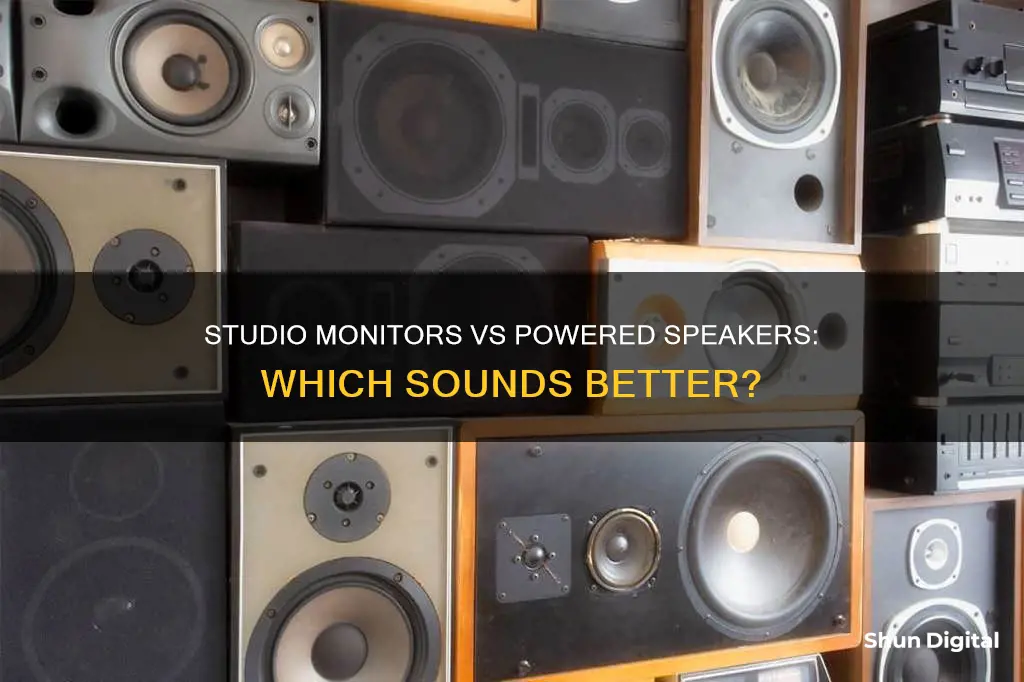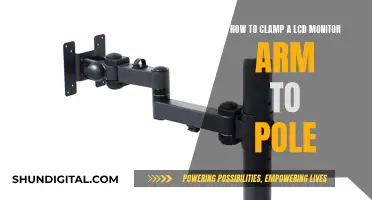
Studio monitors and powered speakers may look similar, but they are designed for different purposes. Studio monitors are used for critical listening, recording, mixing, and mastering audio to a professional degree. They produce a flat frequency response to play back audio recordings exactly as intended without any coloration of sound. Powered speakers, on the other hand, are designed to project sound over larger areas and are typically used for casual listening or home entertainment systems. They may be coloured to sound a particular way by design, enhancing the sound with middle, high, and low frequencies.
What You'll Learn

Studio monitors are designed for critical listening
Studio monitors are crafted with short distances in mind. They are ideal for bedrooms, studios and smaller areas, as they prevent these rooms from enhancing or reducing each sound's true frequency. Studio monitors are also used for inward-facing purposes, so the musician can hear what is being played and stay in tune.
Studio monitors are used for the production aspects of audio products. They are used for mixing and recording rather than listening. They are geared towards professionals and may not be accessible to regular music lovers. Studio monitors are defined by their pro-level intricacies.
Studio monitors are also consistent, featuring a natural playback of most recorded material. They accurately reproduce sounds being played before an environment. They are great for critical listening, recording, radio studios and even television. Studio monitors are the best option for mixing, editing and mastering audio to a professional degree.
Monitoring Home Electricity Usage: A Guide for Indian Households
You may want to see also

Studio monitors are built for short distances
Studio monitors are designed for short distances, also known as nearfield use. This means they are intended to be placed a few feet away from the user, providing a clear and immediate sound. This close proximity prevents the user from hearing natural reverberations, giving a precise impression of the mix.
Studio monitors are not designed to fill a room with sound. Instead, they are geared towards professionals who require critical listening, such as producers, editors, and other musical professionals. They are ideal for small spaces like bedrooms, studios, and smaller areas.
The sound produced by studio monitors is flat and precise, without any emphasis on a particular frequency. This is in contrast to powered speakers, which are designed to project sound throughout a room and are more suitable for larger spaces like living rooms, dens, or outdoor areas.
Studio monitors are also active speakers, meaning they have built-in power amplifiers. This is different from passive speakers, which require power from a dedicated standalone amplifier. With studio monitors, the woofer, midrange, and tweeter cones are each powered individually, resulting in a more precise sound.
The main benefit of studio monitors is their ability to provide a natural playback of recorded material. They accurately reproduce sounds without adding any colouration or enhancements. This makes them ideal for mixing, editing, mastering, and other professional audio tasks.
In summary, studio monitors are designed for short distances, providing a precise and accurate sound for professionals in small spaces. They are a crucial component for anyone serious about creating high-quality mixes.
Monitoring Wattage Usage: Total Control Over Energy Consumption
You may want to see also

Powered speakers are designed to project sound
Powered speakers, also known as self-powered speakers, are designed to project sound over large areas. They are an excellent choice for room-filling audio, social gatherings, home audio, and home theatre listening. They are also ideal for outdoor events, backyard BBQs, and apartment or dorm living.
Powered speakers are designed to work straight out of the box, with just a power outlet and a music source, such as a turntable or CD player, required to get them up and running. They can also be connected to a smartphone or laptop via Bluetooth, making them a versatile option for various settings.
One of the key advantages of powered speakers is their ability to project sound over long distances. They are perfect for near-field (close) listening, with the optimal distance being a few feet away from the listener. This makes them ideal for use in bedrooms, home offices, and small studios, as well as for outdoor events where sound needs to carry over a large area.
Another benefit of powered speakers is their compactness and simplicity. They are designed to be easy to set up and use, making them a popular choice for those who want a straightforward audio solution without the need for complex components. They are also more lightweight than passive speakers, making them easier to transport and set up.
Powered speakers have built-in amplification, so they don't require a separate receiver or amplifier. This makes them a convenient all-in-one solution for audio needs. They are designed to provide clear and precise sound, with individual power amplifiers for the woofer (bass), midrange, and tweeter (treble) cones, resulting in a more accurate and detailed listening experience.
Glossy or Matte: How to Tell Monitor Finishes?
You may want to see also

Studio monitors are used for production
Studio monitors are used for critical listening, allowing you to pick out sonic imperfections so you can fix them. They are designed to have a flat, precise sound for near-field use, meaning they are meant to be placed a few feet away from the listener. This prevents you from hearing natural reverberations, giving you a clear and immediate impression of your mix.
Studio monitors are also active speakers, meaning they have built-in power amplifiers. They tend to have multiple power amplifiers in one unit, allowing the woofer (bass), midrange, and tweeter (treble) cones to be powered individually, resulting in a more precise sound.
Additionally, studio monitors have crossovers, which split frequencies to ensure they go to the right driver (speaker), adding clarity and precision to your mix. They aim to maintain the 'true' frequencies of a song, making them ideal for those who want to preserve the original frequencies, bass, and overall sound.
Studio monitors are consistent and provide a natural playback of recorded material. They accurately reproduce sounds, making them perfect for critical listening, recording, radio studios, and television. They are the best option for mixing, editing, and mastering audio to a professional standard.
In summary, studio monitors are designed for production and offer a flat, precise sound for critical listening and professional audio work. They are an essential tool for anyone seeking to create high-quality audio recordings and mixes.
Deltek's Internet Monitoring: What You Need to Know
You may want to see also

Studio monitors are not suitable for large audiences
Studio monitors are not designed to project sound over large areas. They are crafted for short distances and are best suited for bedrooms, studios, and small areas. They are not ideal for filling a room with sound, as they are meant to sound precise and accurate, rather than pleasing to the ear.
Studio monitors aim to maintain the 'true' frequencies of a song, without enhancing the sound. This makes them excellent for professionals who need to mix, edit, and master audio to a professional degree. However, this also means that they are not as robust as powered speakers and may not be able to reach large audiences.
Powered speakers, on the other hand, are designed to project sound over large areas. They are optimal for room-filling audio and are a better choice for social gatherings, home audio, and home theatre listening. They are also more accessible and affordable for regular music lovers, as studio monitors can be quite expensive.
Studio monitors are designed for a specific purpose and have pro-level intricacies that may not be necessary for a large audience. They are best suited for professionals who need to work with sound in a studio setting. For a large audience, powered speakers would be a more suitable and affordable option.
Hooking Your Predator Helios to a 144Hz Monitor
You may want to see also
Frequently asked questions
Studio monitors are designed to produce a flat frequency response, meaning they play back audio recordings exactly as intended without any coloration to the sound. Powered speakers, on the other hand, are designed to project sound over larger areas and are often "coloured" to sound a particular way.
Studio monitors are ideal for critical listening, recording, mixing, editing, mastering audio, and radio studios. They offer a flat, precise response, allowing for accurate impression and critical listening of the mix.
Studio monitors are geared towards professionals and may not be accessible or desirable for regular music lovers. They are designed for small studio environments and cannot reach large audiences. They also have fewer amplification options than powered speakers.
Powered speakers are ideal for room-filling audio and social gatherings as they can project sound over larger areas. They are also more affordable and suitable for casual listening.







